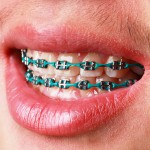
Failure to maintain good oral hygiene during fixed appliance orthodontic treatment can lead to the development of demineralised white lesions (DWLs) around the orthodontic brackets. The incidence of this adverse effect of treatment has bee reported as being between 15-85. A recent Cochrane review by Benson et al (see Dental Elf 27th Jan 2014) found moderate evidence to support the use of fluoride varnishes but the number of studies was small so further studies were recommended to determine the most effective method of preventing DWLs. The aim of this study was to evaluate the effectiveness of daily tooth brushing with high-fluoride toothpaste on DWLs development in adolescents during treatment with fixed orthodontic appliances
Healthy adolescents, 11–16 years of age needing bimaxillary treatment with fixed orthodontic appliances were randomised to either 5000ppm fluoride toothpaste (n=211) or 1450ppm fluoride toothpaste (n=213). Patients were supplied with the designated toothpaste a standardized toothbrush at baseline and every 3rd month throughout the trial. At baseline and after debonding visible DWLs or hypomineralisations on all facial surfaces of the maxillary premolars, canines, and incisors was recorded and 3 standardised digital photos (one frontal and two laterals) were exposed. The primary and secondary outcome measures were the prevalence and incidence of DWLs at the time of debonding, as registered with a 4-step score from digital photos.
1 = no white spot formation; 2 = slight white spot formation (thin rim): 3 = excessive white spot formation (thicker bands); 4 = white spot formation with cavitation. When in doubt, the lower score was chosen.
The fluoride content in the piped drinking water was less than 0.3 ppm F in recruitment areas
- The mean duration of the orthodontic treatment was 1.8 years
- Dropout rate was 10.4% (n=23) in the high-fluoride group and 9.6% (n=21) in the reference group.
- The prevalence of DWLs was significantly lower in high-fluoride group at debonding (P = 0.04).
- DWLs incidence was 18.1% in the high-fluoride group compared with 26.6% in the reference group. This gives a preventive fraction of 32% and a number needed to treat (NNT) of 12.
The authors concluded: –
1. Daily use of high-fluoride toothpaste can significantly reduce the prevalence and incidence of white spot lesions adjacent to fixed orthodontic appliances in adolescents.
2. High-fluoride toothpaste should be considered as one of several alternative fluoride supplements for patients subjected to a temporarily increased caries risk.
Comment
In the discussion the authors compare this study with the varnish study. The varnish study was more effective (with a NNT of 5.5) than the current study although as they point out the varnish was professionally applied so the overall cost-effectiveness may be similar. The authors also discuss patient compliance needs to be taken into account when deciding which treatment should be recommended.
Links
Sonesson M, Twetman S, Bondemark L. Effectiveness of high-fluoride toothpaste on enamel demineralization during orthodontic treatment–a multicenter randomized controlled trial. Eur J Orthod. 2013 Dec 28. [Epub ahead of print] PubMed PMID: 24375756.
